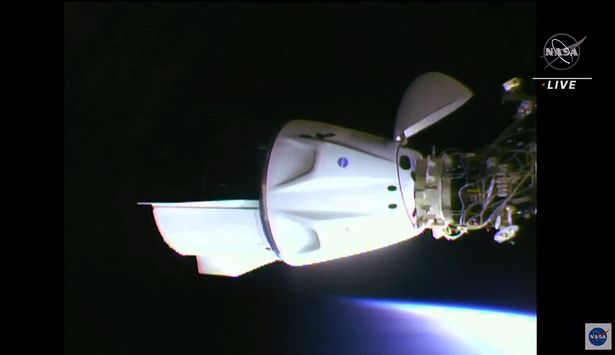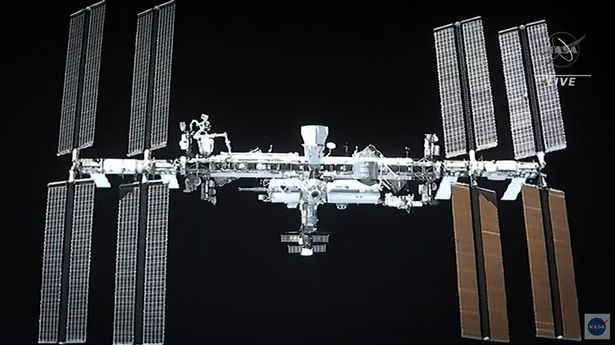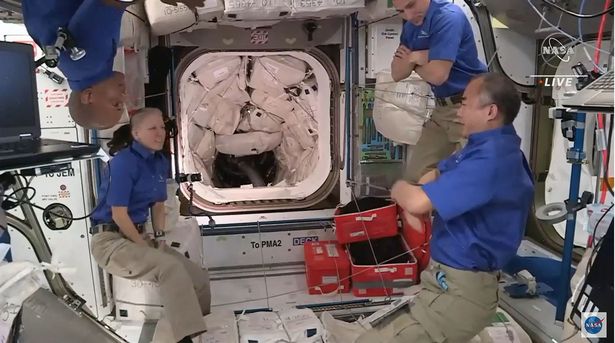A team of astronauts were told to prepare for a collision after ground control spotted a UFO that could hit their vessel.
On Friday the latest joint SpaceX/NASA mission blasted off from the Kennedy Space Centre in Florida.
The mission went smoothly for the first seven hours, after which the four astronauts were warned that an “unknown” object was close to them.
With no time to perform an emergency manoeuvre the space travellers were told to put on their pressurized suits in case of a collision.
NASA spokesperson Kelly Humphries told Futurism : “The possibility of the conjunction came so close to the closest approach time that there wasn’t time to compute and execute a debris avoidance manoeuvre with confidence, so the SpaceX team elected to have the crew don their pressure suits out of an abundance of caution.”

(Image: NASA/AFP via Getty Images)
Luckily for the space travellers the object did not strike the craft.
US Space Command spokesperson Erin Dick added: “After further analysis, the 18 th Space Control Squadron quickly determined there was no conjunction threat, all aboard are safe and the spacecraft was not at risk.”
Humphries said the object was 45km from the vessel at its closest point, which is near enough to be of concern when it comes to space travel.
It remains unclear what the object was however.
On Saturday SpaceX’s Crew Dragon capsule successfully docked at the International Space Station (ISS).
Frenchman Thomas Pesquet is the first European Space Agency (ESA) astronaut to ride in the Crew Dragon spacecraft, which was designed by billionaire technology entrepreneur Elon Musk’s company.

(Image: NASA/AFP via Getty Images)
Also on board is Nasa’s Shane Kimbrough and Megan McArthur, and Jaxa’s (Japan Aerospace Exploration Agency) Akihiko Hoshide on his second mission to the ISS.
The capsule came in to dock at around 10.19am UK time.
It followed the third launch for Nasa’s Commercial Crew programme, which relies on private sector companies operating from the US, in less than a year.
Nasa was previously reliant on the Soyuz shuttle programme for more than a decade.

(Image: NASA/AFP via Getty Images)

(Image: NASA/AFP via Getty Images)
The “recycled” Crew Dragon capsule and Falcon rocket combination sent four astronauts to the ISS last November and the capsule transported and returned two astronauts during the first crewed SpaceX flight last May.
The crew will replace Nasa’s Michael Hopkins, Victor Glover and Shannon Walker, and Jaxa’s Soichi Noguchi, who are scheduled to return to Earth next Wednesday in another SpaceX capsule.
For her debut mission, Ms McArthur is flying on the same seat as her husband Bob Behnken did for SpaceX’s debut crew flight in May last year.
After a six-month stay, the Crew-2 astronauts will leave the ISS in October and splashdown in the Atlantic Ocean off the coast of Florida.
David Parker, director of human and robotic exploration at the ESA, said: “Thomas’ mission is part of a sequence that is taking us on a journey that will, one day, end up with boots on Mars, the red planet.
“But right now, Mars is only a destination for our robots.
“Beyond the space station, one of the things we are doing is preparing for the return to the Moon, or going forward to the Moon, to explore it properly this time.
“So Europe is building the power propulsion for Orion – the new deep spacecraft that will take humans to the Moon. We have three seats aboard that are already planned.”

(Image: NASA/AFP via Getty Images)
He added: “We will learn then on the Moon how to take that much bigger leap eventually to the surface of Mars.”
Mr Pesquet is due to command the ISS during the final month of his six-month mission.
Josef Aschbacher, the ESA’s director general, described the launch as “an emotional moment”.
He said: “As the director general of ESA, I am very happy to see Thomas now flying to the ISS. All of us at ESA are very excited to see this happening.
Mr Aschbacher added: “SpaceX has done an incredible job.”


